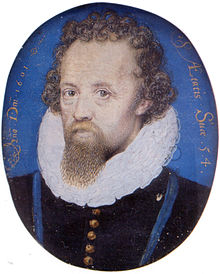George Carey, 2nd Baron Hunsdon
George Carey | |
|---|---|
 George Carey, 2nd Baron Hunsdon, by Nicholas Hilliard, 1601 | |
| 2nd Baron Hunsdon | |
| Reign | 1596–1603 |
| Predecessor | Henry Carey |
| Successor | John Carey |
| Born | 1547 |
| Died | 9 September 1603 |
| Spouse(s) | Elizabeth Spencer |
| Issue | Elizabeth Carey, Lady Berkeley |
| Father | Henry Carey, 1st Baron Hunsdon |
| Mother | Anne Morgan |
George Carey, 2nd Baron Hunsdon KG (1547 – 9 September 1603) was the eldest son of Henry Carey, 1st Baron Hunsdon and Anne Morgan. His father was first cousin to Elizabeth I of England. In 1560, at the age of 13, George matriculated at Trinity College, Cambridge.[1]

Military and political career
[edit]In December 1566 he accompanied the Earl of Bedford on an official mission to Scotland, to attend the baptism of the future King James. Mary, Queen of Scots gave him a ring and a chain with her miniature portrait.[2]
George was sent by his father to see Mary, Queen of Scots, at Bolton Castle in August 1568. They discussed border issues connected with Lord Hunsdon's wardenry. Mary believed that her enemies made false reports against her supporters in the Scottish Borders, hoping the English authorities would make reprisals.[3]
During the Northern Rebellion of 1569, George was knighted in the field by Thomas Radcliffe 3rd Earl of Sussex for bravery. George had challenged Lord Fleming, the commander of Dunbar Castle, to single combat.

George served as a member of Parliament in the Commons for several terms (for Hertfordshire in 1571, for Hampshire in 1584, 1586, 1589, and 1593). He was created Knight Marshal in 1578.[4] He was given the tenure of the lands of the Cornish recusant Francis Tregian when the latter was convicted of praemunire in 1577 for aiding and abetting the missionary priest Cuthbert Mayne.[5]
Carey was sent to Carisbrooke Castle on the Isle of Wight. In 1586, French diplomats complained that as Governor of the Isle he profited from goods taken from merchants ships, including velvet, satin, leather, cardamom, and ivory.[6] He was the commander of the Isle's defenses during the Spanish Armada threat.
In July 1596, when his father died, George became the second Baron Hunsdon, and the following year he was appointed Lord Chamberlain of the Royal Household, a position which had been held by his father.
Theatre
[edit]Both Henry and George Carey were patrons of the professional theatre company in London known as "the Lord Chamberlain's Men". Talents such as William Shakespeare and Richard Burbage were among the writers and performers of the company. In 1597 George was invested as a Knight of the Garter, and it is sometimes proposed that the first performance of William Shakespeare's Merry Wives of Windsor was held to commemorate the occasion.[7]
Family
[edit]George married Elizabeth Spencer (related to poet/author Edmund Spenser), who like her husband was a patron of the arts. They had one daughter, Elizabeth.
Death
[edit]He died on 9 September 1603 (from venereal disease and mercury poisoning), and his brother John (the next eldest) became the third Lord Hunsdon.
References
[edit]- ^ "Carey, George (CRY560G)". A Cambridge Alumni Database. University of Cambridge.
- ^ Thomas Thomson, James Melville: Memoirs of his own life (Edinburgh, 1827), p. 172.
- ^ Allan James Crosby, Calendar State Papers Foreign Elizabeth, 1566–1568 (London, 1871), p. 540 no. 2496.
- ^ "CAREY, Sir George (1547-1603), of Blackfriars, London, Hunsdon, Herts. And Carisbrooke, I.o.W. | History of Parliament Online".
- ^ A.L. Rowse, Tudor Cornwall (1941), MacMillan, 1969, p. 351.
- ^ Sophie Crawford Lomax, Calendar State Papers Foreign Elizabeth, 20 (London, 1921), p. 583.
- ^ Duncan-Jones, Katherine (2001). Ungentle Shakespeare: scenes from his life. London: Arden Shakespeare. p. 97. ISBN 1-903436-26-5.
- Baldacci, Tony (2005). "Sir George Carey's biography". Retrieved 16 July 2005.
- 1547 births
- 1603 deaths
- Alumni of Trinity College, Cambridge
- Carey family
- Knights of the Garter
- Lord-lieutenants of Hampshire
- People of the Elizabethan era
- Members of the Parliament of England for Hertfordshire
- 16th-century English nobility
- 17th-century English nobility
- English MPs 1571
- English MPs 1584–1585
- English MPs 1586–1587
- English MPs 1589
- English MPs 1593
- Barons Hunsdon
